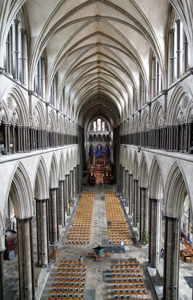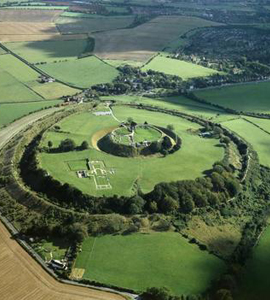The Paleolithic Era's Oregon Trail
The Road from Londinium
Main -- House -- History -- Cornwall -- Getting There -- On the Road -- The Roads -- London -- The Far West -- Boring Details -- Updates
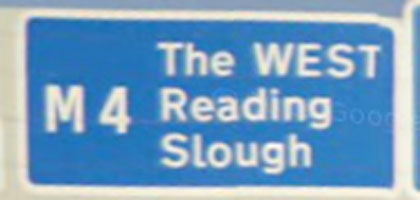 | There is no straight path from London to Cornwall, not least because the British don't believe in straight roads. If you find a straight one, it's probably Roman. But on the way out are a thousand little delights which the typical American in the UK tends to never even hear about, much less stop to see. Their loss, your gain; when the world does know about a place like Stonehenge, the result is a big parking lot ("car park" in UK-ese), a big visitor center ("centre" in UK-ese), a big crowd, and a big admission fee. You wanna see Stonehenge? Well, by all means do. But if you're driving out, think about seeing some of these other sights in addition, or instead. |
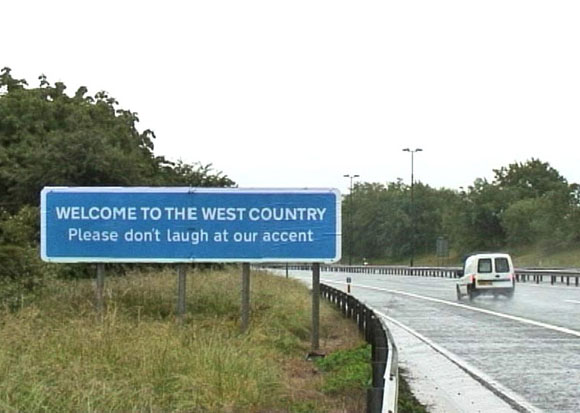
Go West, Young Man, Go "Oooh, Ahr"
The West Country is a funny place. If you want to hear the letter "R" pronounced, it's about the only part of England you'll really find much satisfaction in. For reasons which will probably not really ever become clear to you unless you renounce your U.S. citizenship and become one of them, the British say that people from the West Country sound like this: "Ooh, Ar, Ooh, Ar". Now, they do sound a bit odd, certainly, but not so much in that particular way. Graham Chapman seems to be having a go at the accent here: The Clever Sheep. And once you get out to Cornwall it's a bit different from that stereotypical west-country accent, anyway. Anywho, once you've gotten used to the flying sheep, the West is a lovely place. It's the setting of the great British comic novels, Jude the Obscure and Tess of the D'Urbervilles (theme, in case you don't have time to read 'em: "Just kill yourself now and avoid the suffering."). It's the bit of England that wasn't completely overrun by the Danes back when Vikings were all the rage. And goodness gracious, the history. Salisbury and Winchester cathedrals, if you like things that are old. The Old Sarum, if you like things that are a bit older. Maiden Castle, if The Old Sarum seems a bit newfangled to you. And Avebury, if all of that is just a bit too high-tech and modern for your tastes. And, if you are more the book-larnin' sort, there's Oxford. Or, if you're more the Elizabethan Soap Opera sort of person, there's Stratford Upon Avon. All of this is contained in what amounts to a very compact area, by American standards, and it's not crowded. The English don't go there. They're afraid they'll pick up the accent.
The Vanished English Countryside, Back Again
We used to have a travel guidebook somewhere which basically said of the English countryside: "Yes, you've heard about the lovely English countryside. It's gone, replaced by desolation and fire." Fortunately, all that guidebook proves is that you don't have to actually travel to write a travel book. The amazing thing is that for such a compact and densely-populated country, the English have a tremendous amount of beautiful countryside. You'll enjoy that when you get to the house, but on the way out you can sample some of its delights. Here are a few to consider.
Salisbury, Stonehenge, and the Old SarumSalisbury is a lovely old town, with one of England's great cathedrals. It's a great place for a pleasant afternoon walk, and is just down the road from... The Old Sarum is the original site of the town of Salisbury, and has a massive Norman motte-and-bailey structure in the center of which sits the palace of Bishop Roger, and just outside of which (but inside an iron-age hill fort enclosure) sits the original Salisbury cathedral, now just a kind of stone outline on the ground. Very cool, and a long-occupied site with a lot of history. Old Sarum was one of the infamous "rotten boroughs," municipalities which for centuries had representation in Parliament but no or almost no residents. And the Old Sarum is just a wee bit down the road from... Stonehenge: well, Stonehenge is Stonehenge, and very impressive. Unfortunately, its popularity with tourists has resulted in the monument being "tamed" with fences and a paved pathway so that you can't approach the stones, but it is still glorious and worth a detour if you're in the area. It wasn't built by the Druids, but if you show up in a cloak and plan to offer up Druidic incantations, nobody's likely to stop you. |
Salisbury Cathedral, and the Old Sarum. Yeah, I know, but you already know what that other one looks like. |
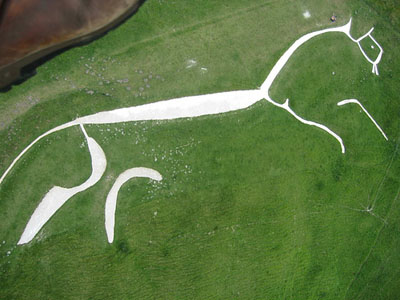 | The Uffington White HorseWhy are the white cliffs of Dover white? Well, that's chalk. Lots, and lots, and lots of chalk, and huge parts of the south of England are in fact a big mound of chalk covered with a thin layer of topsoil. Thousands of years ago, some clever person worked out that it's possible to draw a picture just by digging out the topsoil and leaving white lines on the ground where the chalk is exposed, and so the Brits have the phenomenon of the "chalk hill figure." Most of these are modern. At least one (the "Rude Man of Cerne Abbas," who you've really got to do a Google image search on if you haven't seen him before) is of highly disputed age, with some thinking he's from Britain's Roman period and some thinking he was carved by a detractor of Cromwell in the 17th century. But everyone pretty well agrees that the Uffington White Horse is a truly ancient drawing. If you go to visit the old pony, be careful on the pathways. Chalk is slippery! |
The Avebury ComplexIn our opinion, one of the most amazing places on earth. Avebury is a gigantic stone circle complex, of far greater scale than the better-known Stonehenge. The antiquarian John Aubrey said that it "doth as much exceed in greatness the so renowned Stonehenge, as a cathedral doth a parish Church," and he wasn't kidding. The great stone circle was enclosed in a gigantic bank and ditch; I know that earthworks don't sound exciting, but a good viewing is worth a thousand words and these are really impressive. Approximately one hundred stones, some weighing as much as 40 tons, made up the outer circle, much of which remains intact (the medieval fanatics who pulled these down actually did history a favor by concealing them; later, farmers broke up many of the stones for construction use.) Within were two smaller circles, and extending away were two great stone "avenues." Very close by is the incredible Neolithic tomb known as the "West Kennet Long Barrow," and Silbury Hill, a stupendous earth-mound built out of chalk cobbles. West Kennet alone is worth the detour. Lie on the grass, stare up at the giant stones, and wonder: just what the hell were these people thinking? There's a nice pub in the village of Avebury; get some lunch. | 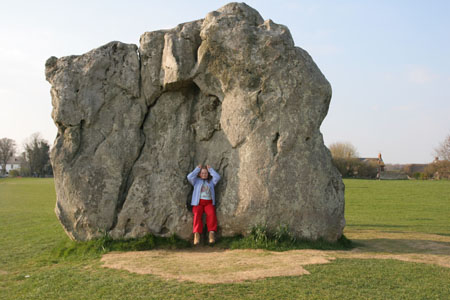 Naomi sitting in "The Devil's Chair," one of the larger stones at Avebury which just happens to have a pleasant seat in the middle. She's provided artificial horns to enhance the effect. |
 The bath in Bath, or the baahth in Baahth, or the bath in Baahth. The pillars and upper level are fake but the rest is the real, Roman thing. |
Bath, and the Baths of Bath, and de-BathificationThe Romans didn't just come to England, mine some tin, and get the heck out of town. No, they stayed, and Roman Britain, though one of the farthest outposts of the Empire, was a relatively fancy and civilized place. In few places is this more apparent than in Bath, where the Romans used the natural hot spring to build a huge bathhouse. After the Romans left, it silted up, and was left almost intact until its rediscovery in the 19th century. It was accompanied by a temple--devoted to Minerva, or as the Celts called her, Sulis, goddess of the waters. Spectacular stuff. The photo on the left shows the main bath but there is much more to see there. Bath also gives you a chance to work out one of those British/American pronunciation mysteries. The British, of course, do not call it "Bath" with the A sound from "cat", and instead say something more like Baahth. Now, Bath has a bath in it. Do you call the town Baahth and the thing in it a bath? Do you call them both a bath because the town is named after the thing in it, or do you call them both Baahth because that's what the English do? And does the fact that some west-countrymen say "Bath" with the American-style A make a difference? By the way, some of the worst traffic in the Western World is in Bath. Hang in there. The baths are worth the trouble, even though you can't bathe in 'em. |
Dartmoor! The Hound of the Baskervilles!Farther west, in Devon, is the gorgeously austere landscape of Dartmoor, the site of the Sherlock Holmes novel The Hound of the Baskervilles. Since a previous trip of ours was to a house situated just outside of Dartmoor, we have a page about it here. To whet your appetite, we present a photo of the best-named lunch-truck business in the world, which sits in the car park at the base of Great Hound Tor. | 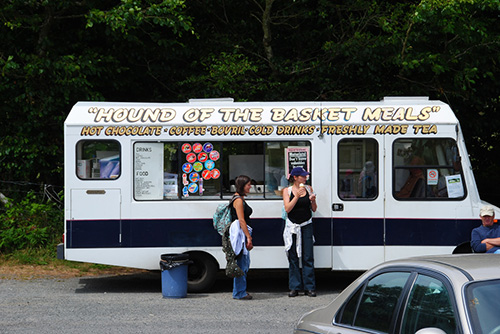 |
And We're Sure There's More...
Well, there's more. Much more. Cheddar Gorge, home of the famous cheese. Winchester, known both for its cathedral and its repeating rifle as well as for being the capital of ancient Wessex. Dorchester, land of Thomas Hardy. Oxford, home of an up-and-coming junior college. Swindon, center of the Great Western Railway. Plymouth, a place so unpopular in the 17th century that even the Pilgrims fled it. It all depends on just what the heck it is you like. The point is that whatever you want to see, there are reasons to jump off the motorway and take in the scenery. Or, you can just make a beeline for Cornwall, home of pasties, piracy and smuggling. Ahr.
